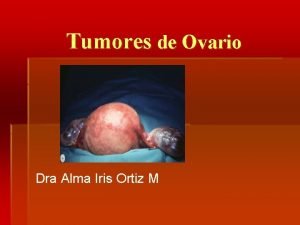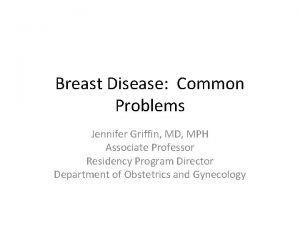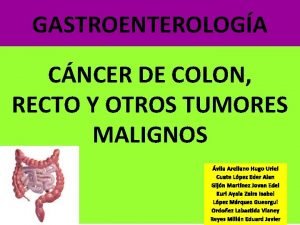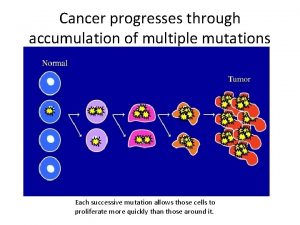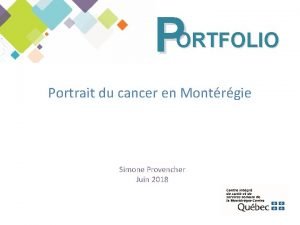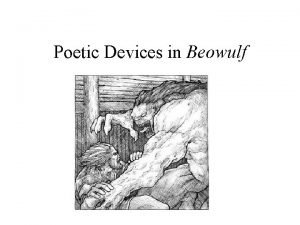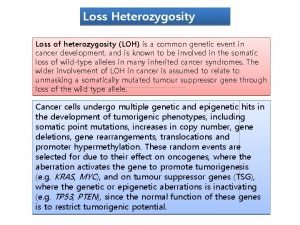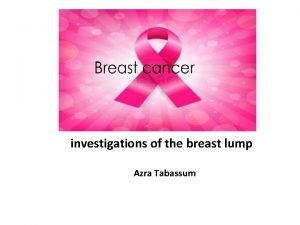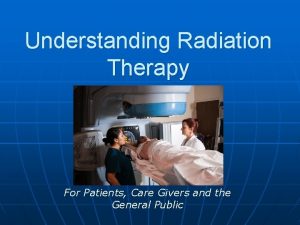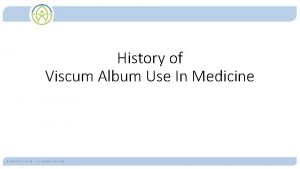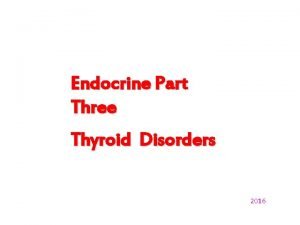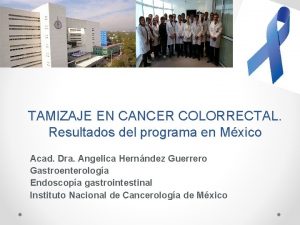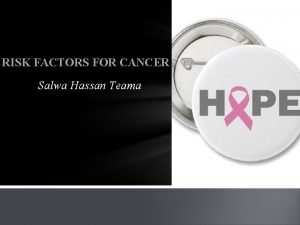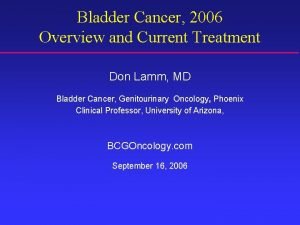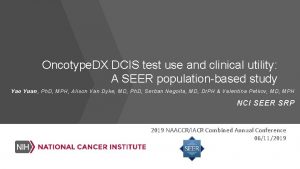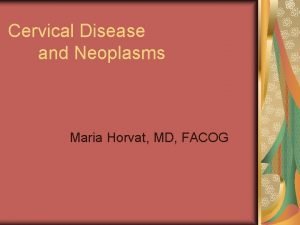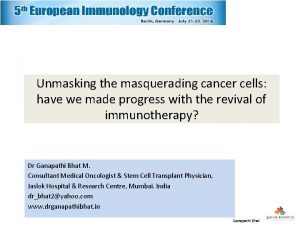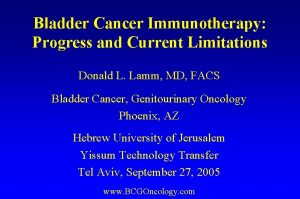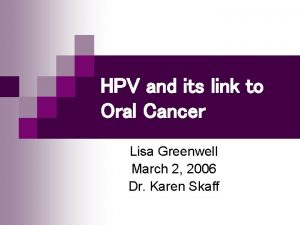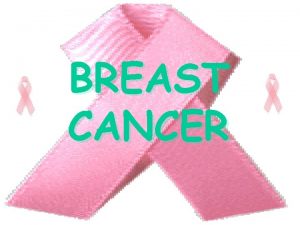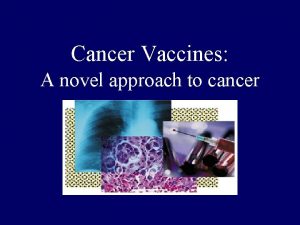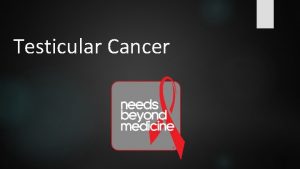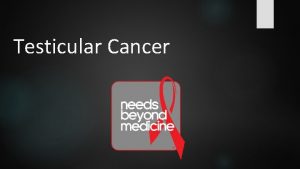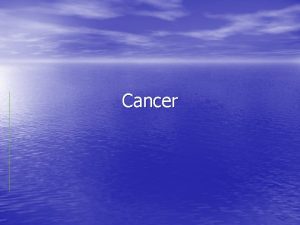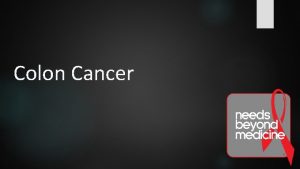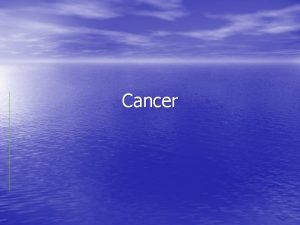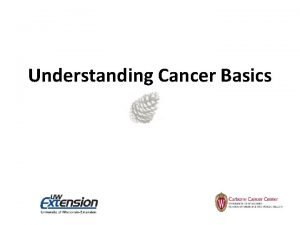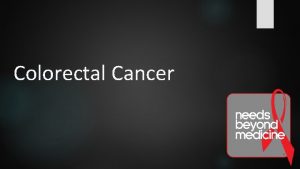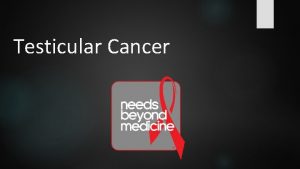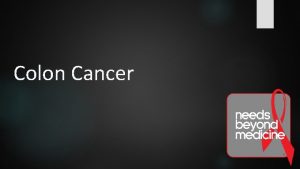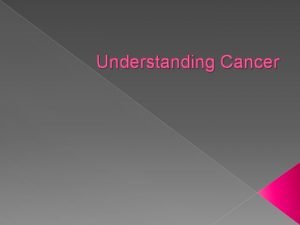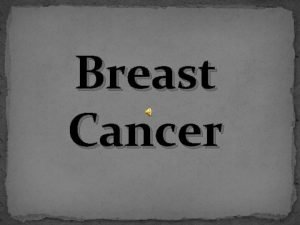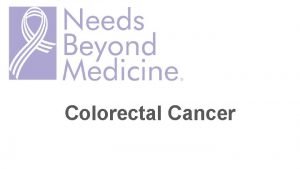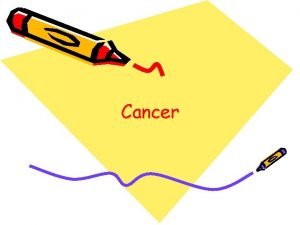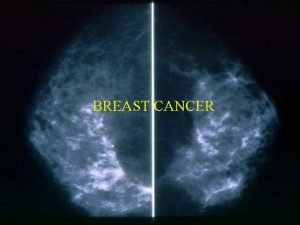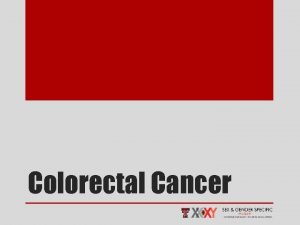CANCER What is cancer CANCER Cancer is a
































- Slides: 32

CANCER What is cancer?

CANCER Cancer is a group of more than 200 diseases characterized by uncontrolled and unregulated growth of cells. Unfortunately a common health problem Early detection is the KEY!

UNCONTROLLED GROWTH Cancer cells from mutation in single cell. This cell then grows without the control that characterizes normal cell growth. At certain stage of development cancer cells fails to mature into normal cell. Starts uncontrolled localized growth-extremely aggressive (local bully on the playground) Can spread from that site (metastasis)to other tissue and organs Primary tumor Metastatic or secondary tumors

HOW CANCER METASTASIZES By circulation through blood and lymphatic system § Venous- travel through veins, commonly to liver and lungs § Lymphatic- cells move thru series of channels from tissues to lymph nodes and eventually the circulatory system, to distant sites in body Accidental transplantation during surgery Spreading to adjacent organs and tissues

WHAT CAUSES CANCER Malfunction of genes that control cell growth and division Cells transformation from normal to cancerous=carcinogenesis Virus factor- animals studies show virus can transform cells. Epstein Barr virus, HPV examples. Overexposed cells- ultraviolet light and sunburns linked to skin cancers Environmental substances- tobacco (Tobacco is related to about 30% of all cancers in North America and is the most important source of preventable carcinogen exposure), asbestos Immune factor- severely compromised system can lead to development (HIV) Foods- colorectal cancer associated with high-protein and high-fat dies, food additives and preparation such as charbroiling

WHAT CAUSES CANCER Genetic factor- usually share these characteristics: early onset, in paired organs (breast), two or more family members has, expensive, should first assess the client’s family cancer history by creating a three-generation family tree. Hormones- estrogen may contribute to some cancer while protecting against others Best defense- one theory suggests we develop cancer cells all the time but our immune system recognizes them and destroys them.

CANCER 101 http: //www. cancer. org/Cancer. Basics/index? ss. Source. Site. Id=null www. cancer. org

CLASSIFICATION Anatomic site § Tumor identified by origin tissue, anatomic site, and behavior (benign, malignant) Histology (grading), poor differentiated=worse prognosis § § Grade I: cells differ slight, well differentiated II: cells more abnormal, moderately differentiated III: very abnormal cells, poorly differentiated IV: immature and primitive cells, undifferentiated, origin hard to determine Extent and spread of disease (staging) 2 major categories § Solid § Hematologic

SOME PREVENTION STRATEGIES Primary and secondary

PREVENTION AMERICAN CANCER SOCIETY RECOMMENDATIONS Individuals § § § Stay at healthy weight during life Adopt a physically active lifestyle Eat healthy diet, with focus on plant sources Limit alcohol intake Educate at every encounter for patient with risk factors such as smoking , sun exposure Community § Work together to make it easy for people to eat better and be more active § www. cancer. org

DIAGNOSIS Health history Physical exam- 7 warning signs (CAUTION) Diagnostics Biopsy- surgical obtainment of tissue from suspected area for histologic study. Will determine if benign or malignant, tissue from tumor arises, degree of cellular differentiation. Genetic testing for predisposition for few specific cancers BRCA 1 (increases risk breast and ovarian cancer).

COLLABORATIVE CARE Cure, control, palliation

7 WARNING SIGNS CANCER What are they?

SURGICAL THERAPY Used to eliminate or reduce risk of cancer Examples include- mastectomy, thyroidectomy, hysterectomy http: //www. cancer. org/Treatmentsand. Side. Effects/Treatment. Types/Surg ery/surgery-and-cancer

CHEMOTHERAPY There are more than 100 chemo drugs used today. Mainstay of cancer therapy. Goal to reduce or eliminate number of malignant cells. Chemo may be used to: • Keep the cancer from spreading. • Slow the cancer’s growth. • Kill cancer cells that may have spread to other parts of the body. • Relieve symptoms such as pain or blockages caused by cancer. • Cure cancer.

CHEMOTHERAPY C el lul ar le vel- kills cancer cells, can also kill healthy cells but most normal cells can repair themselves How given? § Can be pill or liquid and can be taken at home. § Chemo can be given like a flu shot. The shots may be given in your doctor’s office, a hospital, a clinic, or at home. § Most often, chemo drugs are IV (intravenous- central line) chemo. § Swelling at the site may indicate extravasation, and the IV should be stopped immediately § Other types of chemo can be put right into the spine, chest, or belly (abdomen), or rubbed on the skin. § You may get chemo once a day, once a week, or even once a month. It depends on the type of cancer you have and the drugs you are getting. Chemo is usually given with breaks between treatment cycles. This break gives your body time to rebuild healthy new cells and helps you regain your strength. How long you get chemo depends on the type of cancer, your treatment goals, and how your body responds to the drugs. § Often may be combination chemotherapy § Reference: www. cancer. org

CHEMOTHERAPY SIDE EFFECTS N/V- If has N/V give antiemetics at least an hour before chemo Hair loss- wigs, hats, bandanas Bone marrow- blood cell count drops § Thrombocytopenia- increases the client’s risk for prolonged bleeding in response to even minor injury. Mouth and skin- painful oral lesions may affect nutrition Sex life Fertility problems Memory changes- may last awhile even after chemo done- doctors not sure why Emotions- maintain hope, support systems

RADIATION Radiation therapy kills cancer cells. Special equipment sends high doses of radiation to the cancer cells or tumor. This keeps the cells from growing and making more cancer cells. Radiation therapy can also affect normal cells near the tumor. But normal cells can repair themselves and cancer cells cannot. Sometimes, radiation therapy is the only treatment needed. Other times, it is one part of a patient’s treatment. Small doses of radiation are given on a daily basis for a set period of time. This method allows multiple opportunities to destroy cancer cells while minimizing damage to normal tissues. Radiation therapy treats just the tumor. Chemo uses drugs to treat the whole body. So chemo may be used if a person has cancer throughout their body. Radiation is a localized treatment.

RADIATION Radiation that comes from outside your body is called external beam radiation. This uses a machine that sends high-energy rays from outside the body to the tumor and some of the area around the tumor. Radiation therapy that puts a radioactive source inside you is called internal radiation therapy. This type of treatment allows the doctor to give a large amount of radiation to the cancer cells. The radioactive source, which might look like a wire, pellet, or seed, comes in a small sealed container called an implant. The implant is put into or near the tumor, and the radiation travels only a very short distance. It can be left in place forever or just for a short time. If it is left in your body, the implant will stop giving off radiation after some time. Other implants are removed after the right amount of radiation has been given. Iodine 131 - isotope that is eliminated from the body in waste products, especially urine and feces, radioactive for about 48 hours. Having the client not share a toilet with other people or allowing anyone to clean the client’s toilet for a specific period of time ensures that the isotope has been completely eliminated, and that the client’s wastes are no longer radioactive. Consider people with internal radiation and who are exposed to them.

DEALING WITH SIDE EFFECTS AND ALTERED STRUCTURE AND FUNCTION Hematological system GI system Immune System Integumentary system- protect from sun for at least year Genitourinary tract Nervous system Respiratory system CV system Biochemical Psychoemotional- someone who has experienced what pt is going through may be available to help Remember that radiation will affect organs in the radiation path, example: radiation to the abdomen will affect the bowel, and cause frequent diarrhea.

COMPLICATIONS Nutritional Problems § Malnutrition § May have painful oral lesions- apply anesthetic gel to the lesions before the patient eats. § Altered taste sensation- encourage patient to experiment with spices and seasonings Infection § Monitor WBC, routine temperature monitoring § Any sign of infection should be treated promptly!

COMPLICATIONS Infection continued: Neutropenia§ Bone marrow suppression leads to neutropenia and increases the client’s risk for infection § Decreased numbers of neutrophils and other white blood cells can minimize the clinical manifestations of infection. § For this reason, the client may not develop a high temperature, even with severe infection so any elevation of temperature should be reported immediately to the health care provider § Eat a low-bacteria diet-avoiding raw fruits or vegetables and undercooked meat, eggs, or fish. § Filgrastim (Neupogen) is a single-lineage growth factor that stimulates the maturation and release of only segmented neutrophils. This drug is not given unless the neutrophil count is dangerously low.

CANCER PAIN 50% report moderate to severe pain in active tx and 80 -90% with advanced cancer. For chronic cancer pain, analgesics should be taken on a scheduled basis, with additional doses as needed for breakthrough pain. What are some other things we can do?

PSYCHOLOGICAL SUPPORT The risk of recurrence varies by the type of cancer. For breast cancer in postmenopausal women the patient needs at least 20 disease-free years to be considered cured. Some cancers are considered cured after a shorter time span, or after surgery. Survivorship Care Plans § http: //www. cancer. org/Treatment/Survivorship. Duringand. After. Treatment/Survivorship. Care. Pla ns/index Caregivers § http: //www. cancer. org/Treatment/Caregivers/index

CHILDREN http: //www. cancer. org/Treatment/Childrenand. Cancer/When. Your. Child. Has. Cancer/ch ildhood-cancer-late-effects-of-cancer-treatment See evidenced based care sheets

WHAT IS IT? Small slowly enlarging papule

BASAL CELL CARCINOMA (BCC) Frequently associated with sun exposure so educate. BCC spread locally, but rarely metastasize to distant tissues Since BCC can cause local tissue destruction, treatment is indicated Local chemotherapy may be used

WHAT IS IT? Irregular shape with red, white, or blue tones

ANSWER: MELANOMA Most serious type of skin cancer, develops in the cells (melanocytes) that produce melanin Genetic predisposition, UV lights Usually develop in areas that have had exposure to the sun, back, legs, arms, face. Highly metastatic, high death rate To help you identify characteristics of unusual moles that may indicate melanomas or other skin cancers, think of the letters A-B-C-D-E: A is for asymmetrical shape. Look for moles with irregular shapes, such as two very differentlooking halves. B is for irregular border. Look for moles with irregular, notched or scalloped borders — characteristics of melanomas. C is for changes in color. Look for growths that have many colors or an uneven distribution of color. D is for diameter. Look for new growth in a mole larger than 1/4 inch (about 6 millimeters). E is for evolving. Look for changes over time, such as a mole that grows in size or that changes color or shape. Moles may also evolve to develop new signs and symptoms, such as new itchiness or bleeding.

WHAT IS IT? Firm nodular lesion topped with a crust or with a central area of ulceration

ANSWER: SQUAMOUS CELL CARCINOMA Common form of skin cancer that develops in the thin, flat squamous cells that make up the outer layer of the skin. Invade locally and can metastasize via lymphatic system Larger tumors more prone to metastasize Chronic skin damage from repeated injury of irritation predisposes person, UV lights Signs and symptoms of squamous cell carcinoma include: A firm, red nodule A flat sore with a scaly crust A new sore or raised area on an old scar or ulcer A rough, scaly patch on your lip that may evolve to an open sore A red sore or rough patch inside your mouth

EDUCATION What type of education will you give your patients in regards to skin cancer?
 Ginandroblastoma
Ginandroblastoma Symboler dikt
Symboler dikt Jennifer griffin md
Jennifer griffin md Facies de la cara
Facies de la cara Kennings for a hero
Kennings for a hero Sigmoidectomia
Sigmoidectomia Cancer mutations
Cancer mutations Cancer du col
Cancer du col Luminal a breast cancer
Luminal a breast cancer Cancer
Cancer Cancer stick kenning meaning
Cancer stick kenning meaning Loss of heterozygosity
Loss of heterozygosity Self breast exam
Self breast exam Esfago
Esfago Cancer treatment
Cancer treatment Cancer burden of disease
Cancer burden of disease Euthyroid hashimoto's
Euthyroid hashimoto's Cancer colon
Cancer colon Tobacco causes cancer
Tobacco causes cancer Cancer biology
Cancer biology Risk factors of cancer
Risk factors of cancer What is diabetes insipidus
What is diabetes insipidus Canceres una palabra aguda grave o esdrujula
Canceres una palabra aguda grave o esdrujula Oncovite bladder cancer
Oncovite bladder cancer Mammoprint
Mammoprint Cancer in situ
Cancer in situ Northern institute for cancer research
Northern institute for cancer research Stage 4 cervical cancer
Stage 4 cervical cancer Nature reviews
Nature reviews Cancer vaccines
Cancer vaccines Oncovite bladder cancer
Oncovite bladder cancer Definition of cancer according to who
Definition of cancer according to who Carcinoma bronquioloalveolar
Carcinoma bronquioloalveolar
